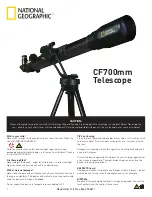
same size as they look in your eyepiece. You
will see that the moons are in a different
position every night. As you get better at
drawing, try more challenging sights, like a
crater system on the moon or even a nebula.
Go your library or check out the internet for
more information about astronomy. Learn
about the basics: light years, orbits, star
colors, how stars and planets are formed,
red shift, the big bang, what are the different
kinds of nebula, what are comets, asteroids
and meteors and what is a black hole. The
more you learn about astronomy, the more
fun, and the more rewarding your telescope
will become.
SOME OBSERVING TIPS
Eyepieces: Always begin your observations
using the 25mm low-power eyepiece. The
25mm eyepiece delivers a bright, wide field
of view and is the best to use for most
viewing conditions. Use the high-power 9mm
eyepiece to view details when observing the
Moon and planets. If the image become
fuzzy, switch back down to a lower power.
Changing eyepieces changes the power or
magnification of your telescope.
By the way, you might have noticed
something strange when you looked through
your eyepiece. The image is upside down and
reversed. That means reading words can be
a problem. But it has no affect on
astronomical objects.
2X Barlow lens: You can also change
magnification by using a Barlow lens. The
Barlow lens doubles the power of your
telescope (See Fig. 9).
Meade offers a complete line of eyepieces
for your telescope. Most astronomers have
four or five low-power and high power
eyepieces to view different objects and to
cope with different viewing conditions.
Objects move in the eyepiece: If you
are observing an astronomical object
(the Moon, a planet, star, etc.) you
will notice that the object will begin to
move slowly through the telescopic
field of view. This movement is
caused by the rotation of the Earth and
makes an object move through the tele-
scope’s field of view. To keep astronomical
objects centered in the field, simply move
the telescope on one or both of its axes—
vertically and/or horizontally as needed—try
using the telescopes coarse and fine
adjustment controls. At higher powers,
astronomical objects will seem to move
eyepiece
barlow
STAR CHARTS
Star charts and planispheres are useful for a variety of
reasons. In particular, they are a great aid in planning a
night of celestial viewing.
A wide variety of star charts are available in books, in
magazines, on the internet and on CD Roms. Meade
offers AutoStar Suite
TM
software. Contact your local
Meade dealer or Meade’s Customer Service department
for more information.
Astronomy
and
Sky and Telescope
magazines print star
charts each month for up-to-the-minute maps of the
heavens.
Fig. 9
13
Meade80EQ-AR 4/28/06 9:55 AM Page 15








































